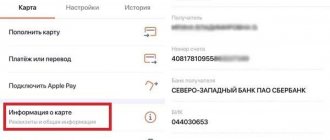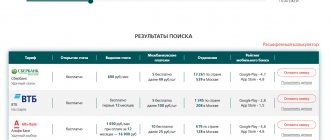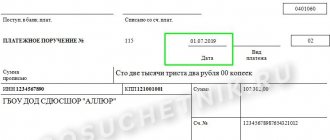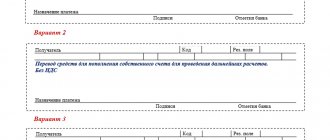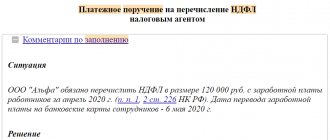Payment order is an official instruction for the transfer of funds submitted to the bank by the owner of the current account.
If there is a bank mark on execution, it becomes the primary accounting document confirming the fact of debiting money from the account and is an attachment to the bank statement. Therefore, the payment order is the basis for the formation of appropriate accounting entries and analytical accounting records.
The document is accepted by the bank even if there is no money in the client’s account. The validity period is 10 days, and during this period the document can be in the bank awaiting the arrival of money. In this case, funds can be written off either once or several times.
How to provide the original payment order to the AS?
In this case, the last copy is transferred to the client to reflect transactions on writing off funds in his accounting. In addition, the client is provided with an extract from his account about the flow of funds on it, which indicates the following information:
· client's name and account number;
· the date on which the statement was drawn up;
· balance of funds in the client's account at the beginning of the day;
· amounts credited to the client’s account during the day, including through the cash register;
· amounts debited from the client’s account during the day using various payment documents and on other grounds;
· balance of funds in the client's account at the end of the day.
The procedure for making payments by payment orders can be represented as the following diagram:
1.The emergence of an obligation of the Payer to the Recipient to pay a certain amount of money (purchase and sale of goods or other valuables, provision of services, other grounds);
2.The Payer provides the bank serving him with four copies of the payment order for the transfer of funds to the Recipient;
3.The Payer's bank debits the payment amount from his bank account, puts a mark on execution on the payment order and transfers its fourth copy to the Payer;
4.The Payer's Bank transfers the payment amount to the Recipient's Bank and transfers to it the second and third copies of the payment order. The first copy with the signatures and seal of the Payer and with a mark of execution remains in the Payer’s Bank and is filed in the documents of the day;
5.The Recipient's bank credits the received funds to the Recipient's account, puts a mark of execution on the received copies of the payment order and transfers one of them to the Recipient, and files the other in the documents of the day.
Date of publication: 2015-01-23; Read: 147 | Page copyright infringement
When filing a statement of claim or complaint in court, you must provide proof of payment of the state fee.
Do I need to print bank statements and payments?
A printed payment order with the bank's execution mark may be required in various situations, for example, as confirmation of payment of a state duty or tax.
In accounting, payments are usually printed as an appendix to a bank statement. If an organization makes a large number of payments every day, this can be quite inconvenient.
The legislation does not precisely regulate whether it is mandatory to print electronic payment orders or whether a bank statement is sufficient. Primary documents signed with an enhanced digital signature can be accepted by the tax authorities as confirmation of expenses, and accordingly it is not necessary to print them out - the Ministry of Finance has repeatedly pointed this out in its clarifications (for example, letter of the Ministry of Finance of the Russian Federation dated January 13, 2016 No. 03-03-06/1/259 ). An exception is a request for a document on paper, a discrepancy between electronic formats, when an electronic document cannot be submitted to the Federal Tax Service, etc. situations.
Read more: Restoration of parental rights after deprivation
Payment order for payment of state duty in electronic form
For an organization, this is usually a payment order with a bank mark. Payments are mainly made electronically. However, is it enough to attach a printout of an electronic payment document to confirm that the state duty has been paid? As practice shows, a court of general jurisdiction and an arbitration court have different approaches.
Electronic payments
In accordance with the requirements of the Civil Procedure Code of the Russian Federation and the Arbitration Procedure Code of the Russian Federation, a document confirming payment of the state duty is attached to the statement of claim, appeal and cassation complaint. If the specified document is missing, the statement of claim or complaint may be returned to the applicant. Payment of the state duty can be made by transferring funds by bank. For a legal entity this is the most convenient option. Transfers of funds by banks are carried out by order of the client electronically or on paper. According to Art. 333.18 of the Tax Code of the Russian Federation, the fact of payment of the state duty by the payer in non-cash form is confirmed by a payment order with a note from the bank or the relevant territorial body of the Federal Treasury (another body that opens and maintains accounts), including one that makes payments in electronic form, about its execution. The rules for transferring funds are regulated by Bank of Russia Regulation No. 383-P dated June 19, 2012. In accordance with clause 4.6 of Regulation N 383-P, the execution of an order in electronic form for the purpose of transferring funds to a bank account is confirmed by the payer’s bank by sending the payer a notice in electronic form about the debiting of funds from the payer’s bank account indicating the details of the executed order or by sending the executed order in electronic form indicating the execution date. In this case, the specified notice from the payer’s bank can simultaneously confirm the acceptance of the order for execution in electronic form and its execution.
Arbitration court
Based on these rules of law, arbitration courts accept statements of claim and complaints if the fact of payment of the state duty is confirmed by printing an electronic payment document containing all the details (the date of debiting the funds, the type of payment - “electronic”, a note about the payment). For example, in the Resolutions of the FAS SZO dated 02.13.2014 in case No. A26-5598/2013, FAS VSO dated 08.20.2012 in case No. A19-9761/2012, judicial acts on the return of statements of claim were canceled, since they were based on the explanations of the information letter Presidium of the Supreme Arbitration Court of the Russian Federation dated May 25, 2005 N 91 (currently inactive), according to which, in confirmation of payment of the state duty, a payment order must be submitted with a bank stamp and with the signature of the responsible executor. The cassation court explained that such requirements apply to the execution of a payment order on paper. When transferring funds electronically, the payment order must indicate: type of payment - “electronic”, date of debiting the funds, bank mark confirming the payment. The electronic version of the payment order executed in this way was recognized by the court as complying with paragraph. 2 p. 3 art. 333.18 Tax Code of the Russian Federation.
Court of General Jurisdiction
A court of general jurisdiction, when resolving the issue of submitting a document confirming payment of the state duty, proceeds from the fact that the applicant must submit a duly certified payment order. In other words, a payment order with the bank’s blue seal, certified by a bank employee, is required. For example, cassation rulings of the Moscow City Court dated 02.09.2015 N 4g/2-9494/15, dated 26.06.2015 N 4g/2-6865/15 returned cassation appeals. The court motivated the return by the fact that the attached printout of the payment order form from the electronic system is not properly executed and is not certified in the prescribed manner: it does not contain the signature of a bank employee on the bank’s mark on acceptance of the payment order, the bank’s seal and the mark on the transfer of state duty to the budget, duly certified. Similar requirements for a payment order when transferring state fees electronically were presented, for example, in case No. 33-2119 (Appeal ruling of the Kirov Regional Court dated June 17, 2014).
At extra charge
As a rule, the bank issues a payment order with a blue seal for an additional fee. It is clear that this is regulated by an agreement between the bank and the client. However, if this service is paid, then you cannot argue with the bank, and you will have to pay for issuing a payment card certified by the bank. In accordance with Art. 46 of the Constitution of the Russian Federation, everyone is guaranteed judicial protection of their rights and freedoms. In fact, having paid the state fee, but not being able to pay for the service for receiving a printout of the payment order with a blue seal from the bank, the legal entity will be deprived of the right to judicial protection. After all, a statement of claim or complaint will not be accepted for processing until a payment order with the bank’s blue seal is submitted. Consequently, the requirement to submit a payment order with a bank stamp indicating payment of state duty with a blue seal may create an obstacle to judicial protection and increase legal costs. Especially for an organization that, due to the nature of its activities, is often forced to go to court to collect any periodic payments (for example, utility bills from the population). It seems logical to accept procedural documents when submitting a printout of an electronic payment order for payment of state duty. And only if there are doubts about their authenticity, require additional evidence.
If you do not find the information you need on this page, try using the site search:
Step-by-step instructions for filling out a payment order
On the sample form, each cell is assigned a number to make it easier to explain its meaning and clarify exactly how it needs to be filled out.
Check whether you are using the current payment order form, updated in 2012. The new form is approved by Appendix 2 to the Regulation of the Bank of Russia dated June 19, 2912 No. 383-P.
Check the number listed at the top right. No matter who the money sent via payment order is intended for, the same numbers will be indicated - 0401060 . This is the form number of the unified form valid today.
We begin to fill out the fields of the document one by one. Field 3 – number. The payer indicates the payment number in accordance with its internal numbering order. The bank can provide the number to individuals. This field cannot contain more than 6 characters.
Field 4 – date. Date format: two digits day, two digits month, 4 digits year. In electronic form, the date is formatted automatically.
Field 5 – type of payment. You need to choose how the payment will be made: “urgent”, “telegraph”, “mail”. When sending a payment through a client bank, you must indicate the encoded value accepted by the bank.
Field 6 – amount in words. The number of rubles is written with a capital letter in words (this word is not abbreviated), kopecks are written in numbers (the word “kopek” is also without abbreviations). It is acceptable not to indicate kopecks if the amount is a whole amount.
Field 7 – amount. Transferred money in numbers. Rubles must be separated from kopecks with the sign – . If there are no kopecks, put = after the rubles. There should be no other characters in this field. The number must match the words in field 6, otherwise the payment will not be accepted.
Field 8 – payer. Legal entities must indicate the abbreviated name and address, individuals - full name and registration address, those engaged in private practice, in addition to this data, the type of activity, individual entrepreneur - full name, legal status and address must be noted in brackets. The name (title) is separated from the address by the // symbol.
Field 9 – account number. This refers to the payer's account number (20-digit combination).
Field 10 – payer bank. Full or abbreviated name of the bank and the city of its location.
Field 11 – BIC. Identification code belonging to the payer’s bank (according to the Directory of participants in settlements through the Central Bank of Russia).
Field 12 – correspondent account number. If the payer is served by the Bank of Russia or its division, this field is not filled in. In other cases, you need to indicate the subaccount number.
Field 13 – beneficiary bank. The name and city of the bank where the funds are sent.
Field 14 – BIC of the recipient's bank. Fill in the same way as clause 11.
Field 15 – recipient's subaccount number. If money is sent to a client of the Bank of Russia, there is no need to fill out the box.
Field 16 – recipient. A legal entity is designated by its full or abbreviated name (both can be done at once), an individual entrepreneur - by status and full name, privately practicing individual entrepreneurs must additionally indicate the type of activity, and it is enough to name an individual in full (without inclination). If funds are transferred to the bank, then the information from field 13 is duplicated.
Read more: Refund of overpaid personal income tax to an individual
Field 17 – recipient's account number. 20-digit account number of the recipient of the funds.
Field 18 – type of operation. The code established by the Central Bank of the Russian Federation: for a payment order it will always be 01.
Field 19 – payment term. The field remains empty.
Field 20 – purpose of payment. See paragraph 19, until the Central Bank of the Russian Federation indicates otherwise.
Field 21 – payment queue. A number from 1 to 6 is indicated: queue in accordance with Article 855 of the Civil Code of the Russian Federation. The most commonly used numbers are 3 (taxes, contributions, salaries) and 6 (payment for purchases and supplies).
Field 22 – UIN code. A unique accrual identifier was introduced in 2014: 20 digits for a legal entity and 25 for an individual. If there is no UIN, 0 is entered.
Field 23 – reserve. Leave it blank.
Field 24 – purpose of payment. Write down what the funds are being transferred for: name of the product, type of service, number and date of the contract, etc. It is not necessary to indicate VAT, but it is better to be on the safe side.
Field 43 – payer’s stamp. Placed only on a paper version of the document.
Field 44 – signatures. On paper, the payer puts a signature that matches the sample on the card submitted when registering the account.
Field 45 – bank marks. On the paper form, the banks of the sender and recipient of the funds put stamps and signatures of authorized persons, and in the electronic version - the date of execution of the order. Field 60 – payer’s tax identification number. 12 characters for an individual, 10 for a legal entity. If there is no TIN (this is possible for individuals), write 0.
Field 61 – recipient’s TIN. Similar to paragraph 28.
Field 62 – date of receipt at the bank. Fills the bank itself.
Field 71 – write-off date. Issued by the bank.
IMPORTANT! Cells 101-110 must be filled out only if the payment is intended for tax or customs.
Field 101 – payer status. Code from 01 to 20, specifying the person or organization transferring the funds. If the code is in the range from 09 to 14, then field 22 or field 60 must be filled in without fail. Field 102 – payer checkpoint. Registration reason code (if available) – 9 digits.
Field 103 – recipient checkpoint. 9-digit code, if assigned. The first two digits cannot be zeros.
Field 104 – KBK. New for 2021. The budget classification code reflects the type of income of the Russian budget: duty, tax, insurance premium, trade fee, etc. 20 or 25 characters, all digits cannot be zeros.
Field 105 – OKTMO code. Indicated since 2014 instead of OKATO. According to the All-Russian Classifier of Municipal Territories, you need to write in this field 8 or 11 digits assigned to your locality.
Field 106 – basis of payment. The code consists of 2 letters and indicates various reasons for payment, for example, OT - repayment of deferred debt, DE - customs declaration. In 2016, several new letter codes were introduced for the basis of payment. If the list of codes does not indicate the payment that is made to the budget, 0 is entered in the cell.
Field 107 is an indicator of the tax period. It is noted how often the tax is paid: MS - monthly, CV - once a quarter, PL - every six months, GD - annually. The date is written after the letter designation. If the payment is not tax, but customs, the code of the relevant authority is written in this cell.
Field 108 – payment basis number. From March 28, 2016, in this field you need to write the number of the document on the basis of which the payment is made. The document is selected depending on the code specified in field 107. If cell 107 contains TP or ZD, then 0 must be entered in field 108.
Field 109 – date of the payment basis document. Depends on field 108. If there is 0 in field 108, 0 is also written in this cell.
Field 110 – payment type. The rules for filling out this field changed in 2015. This cell does not need to be filled out, since field 104 indicates the KBK (its 14-17 digits precisely reflect the subtypes of budget revenues).
Read more: If you temporarily register a child, what are the consequences?
Payment order as proof of transaction
Marat Galimov, newspaper "EZH-Lawyer".
An individual entrepreneur provided a loan to an organization by transferring the loan amount to the borrower’s bank account. In the payment order, the purpose of payment states: “Provision of the loan amount under the loan agreement.” We did not conclude the agreement itself. Is this payment order evidence of the conclusion of a loan agreement between the parties and, accordingly, confirmation of the fact of transfer of funds to the borrower under this agreement? Will the lender be able to legally recover the loan amount and interest for the use of funds?
V. Bykov, Astrakhan
Under a loan agreement, one party (the lender) transfers into the ownership of the other party (borrower) money or other things determined by generic characteristics, and the borrower undertakes to return to the lender the same amount of money (loan amount) or an equal number of other things received by him of the same kind and quality (Clause 1 of Article 807 of the Civil Code of the Russian Federation).
In this case, the loan agreement is considered concluded from the moment of transfer of money or other things (paragraph 2 p.
Basic concepts and definitions
In order to understand the additional (compared to a “regular” payment order) fields in a foreign currency payment order, you should study a little the technique of international transfers.
After all, we almost always pay foreign counterparties in foreign currency. Foreign exchange payments with resident partners are prohibited by law, with rare exceptions (Article 9 of Law No. 173-FZ dated December 10, 2003 “On Currency Control”). Read more about settlements with non-residents: “Currency transactions between residents and non-residents” .
International transfers require slightly more information than domestic transactions. It is most appropriate to give their names (designations) and decipher the essence a little so that it is clear why separate fields in the currency order are dedicated to them.
SWIFT is an international banking association. Banks servicing international payments register with SWIFT and receive an individual identifier code with the same name. Indicating the SWIFT code in the payment order allows you to clearly identify the bank to which the payment goes. Actually, the SWIFT code is an 11-digit electronic “address” of the bank in the SWIFT system.
BIC code is the same as SWIFT. The name is used from the ISO 9362 standard, which regulates methods for identifying participants in financial transactions.
BEI code is also an identifier in SWIFT, but not of a bank, but of a corporate client of this bank. The bank can register its clients in the SWIFT system to increase the speed and accuracy of settlements. The BEI code also helps ensure that the payment sent goes to its destination.
Bank clearing code is also a bank identifier, but not in SWIFT, but in national clearing systems.
IBAN is another practically complex identifier: it identifies the bank (branch) and the client’s account number in the international format (ISO 13616 standard).
ISO code - part of the ISO 3166-1 standard contains codes for the names of countries and subordinate territories. Used to indicate addresses in a payment document.
IMPORTANT! There are other similar encodings. For banking purposes, ISO 3166-1 should be used.
Address - any address is indicated in the sequence: street, house number, city, district, postal code, country (can be ISO code). This is an international format.
The beneficiary is the one to whom we pay.
Intermediary bank (correspondent bank) - indicated if the beneficiary's bank directly holds an account in the corresponding currency with another bank (intermediary).
Thus, technically, the process of creating a correct payment order in currency is the correct indication of all identifiers of the payee and his bank.
There are several more pitfalls along the way of performing international translation, which are also worth dwelling on in more detail:
- Prohibited SWIFT characters - the settings of this system do not allow characters to pass through
№ % # $ & @ ” = \ { } [ ] ; * « » ! _ < >
In addition, the system automatically replaces them with valid ones. Thus, the sequence of characters in the identifiers may be broken and an error may occur.
- Information for client identification is the necessary information required by a Russian bank according to the provisions of Law No. 115-FZ dated 08/07/2001. Without specifying information about the client, as well as providing information on additional requests, the bank may simply not execute the payment.
Read more about this here: “The procedure for identifying a client in a bank according to law 115-FZ”
- The bank blacklist is a directory that contains information about persons, organizations, states and territories of registration (incorporation) in respect of which there are restrictions on banking transactions or transactions with which should be considered questionable. For clients who are somehow blacklisted, transactions may be difficult or even impossible.
ConsultantPlus experts explained how foreign exchange payments and control of foreign exchange transactions are carried out. To do everything correctly, get trial access to the system and go to the Ready solution.
Settlements by payment orders
1 tbsp. 807 of the Civil Code of the Russian Federation). This condition indicates the real nature of the loan agreement.
A loan agreement between citizens must be concluded in writing if its amount exceeds at least ten times the minimum wage established by law or when the lender is a legal entity - regardless of the amount (clause 1 of Article 808 of the Civil Code of the Russian Federation).
In confirmation of the loan agreement and its terms, a receipt from the borrower or another document certifying the transfer by the lender of a certain amount of money or a certain number of things can be presented (clause 2 of Article 808 of the Civil Code of the Russian Federation).
When making payments by payment order, the bank undertakes, on behalf of the payer, at the expense of the funds in his account, to transfer a certain amount of money to the account of the person specified by the payer in this or another bank within the period provided for by law or established in accordance with it, unless a shorter period is specified. is provided for by the bank account agreement or is not determined by the business customs used in banking practice (clause 1 of Article 863 of the Civil Code of the Russian Federation).
The form of the payment order is established by Appendix No. 1 to the Regulations on non-cash payments in the Russian Federation, approved by the Central Bank of the Russian Federation on October 3, 2002 No. 2-P.
According to clause 3.1 of the Regulations, a payment order is an order from the account owner (payer) to the bank servicing him, documented in a payment document, to transfer a certain amount of money to the recipient’s account opened in this or another bank. In accordance with clause 3.2 of the Regulations, payment orders can be used to transfer funds for the purpose of returning/placing credits (loans)/deposits and paying interest on them, transferring funds for other purposes provided for by law or agreement.
Regarding whether a payment order is evidence of the conclusion of a loan agreement, there are two positions of the courts.
First: the fact of transfer of funds under a loan agreement on the basis of a payment order can be recognized as the conclusion of a loan agreement between the parties, but only in conjunction with other evidence in the case. This conclusion is confirmed by materials of judicial practice.
Thus, the Supreme Arbitration Court of the Russian Federation, in Resolution No. 13966/09 dated January 19, 2010, established that in the period from June 1, 2006 to July 31, 2006, the lender transferred funds to the borrower, which was confirmed by the relevant payment orders, a certificate from the lender’s bank and was not disputed by the defendant in the original claim. Later, the lender approached the borrower with a demand for the return of the funds received. The appellate court, based on the provisions of Art. 808 of the Civil Code of the Russian Federation, allowing, in support of the loan agreement, to present a receipt from the borrower or other documents certifying the transfer by the lender of a certain amount of money or a certain number of things, and stating the absence in the case materials of the original of the disputed loan agreement or its duly certified copy, as well as an indication in payment orders in in the “Purpose of payment” column as the basis for the transfer of funds “financial assistance”, came to the conclusion that these circumstances do not indicate that an interest-free loan agreement was not concluded. It was also stated that the lender documented the provision of the loan amount to the borrower.
Other grounds for transferring funds specified in payment orders do not exempt the defendant from returning them to the plaintiff, since, within the meaning of civil law, obligatory legal relations between commercial organizations are based on the principles of remuneration and equivalence of the exchanged material objects, and the inadmissibility of unjust enrichment.
In another case, the FAS ZSO, in Resolution No. A70-9893/2009 dated 07/08/2010, indicated that the fact that the loan amount was provided is confirmed by available payment orders. In addition, the fact of receipt of funds from the plaintiff and the amount of debt were confirmed by the act of reconciliation of payments submitted to the case materials, signed by the parties and sealed. The court indicated that by virtue of paragraph 2 of Art. 808 of the Civil Code of the Russian Federation, the payment orders submitted to the case to transfer sums of money to the defendant as borrowed funds confirm the existence of a loan agreement between the parties.
FAS DO in Resolution No. F03-7848/2009 dated January 22, 2010 noted that a loan agreement was concluded between the borrower and the lender, under the terms of which the lender agreed to transfer the loan amount to the borrower. With a payment order, the lender transferred the loan amount to the borrower, indicating in the purpose of payment “transfer under the loan agreement.” The court indicated that the loan agreement is real in nature and is considered concluded from the moment funds are provided to the borrower. The FAS also established the fact that the lender fulfilled its obligations under the loan agreement: the transfer of funds to the defendant under a payment order and the assignment of payment under the payment order against the loan agreement.
Based on this, the court came to the conclusion that there was a contractual relationship between the parties to the case and recovered from the defendant the amount of debt and interest for the use of borrowed funds.
The second position: the presence of a payment order does not confirm the fact of the conclusion of a loan agreement between the parties in the absence of a loan agreement signed by the parties.
Thus, the FAS ZSO in Resolution No. A70-4325/2010 dated December 22, 2010 indicated that from the case materials it follows that the lender transferred the loan amount to the borrower by payment order, indicating as the purpose of payment “the provision of an interest-free loan under a loan agreement.” Evidence confirming the existence of a contractual relationship between the parties, in pursuance of which the disputed funds were transferred, as well as documents indicating that the parties entered into a loan agreement, were not presented in the case materials. At the same time, the transfer by the lender of funds by payment order indicating the purpose of payment “providing an interest-free loan under a loan agreement” in the absence of a loan agreement in the case file in the form required in appropriate cases (Article 808 of the Civil Code of the Russian Federation) does not indicate the emergence of a borrowing relationship between the parties.
In another case, the Federal Antimonopoly Service NWO, in Resolution No. A56-44572/2005 dated September 21, 2007, indicated that the lender, on the basis of a payment order, transferred the loan amount to the borrower. In the payment orders, in the column “Purpose of payment” it was indicated: “Transfer of funds under a loan agreement w/n.” Having considered that the borrower received a loan of funds in the specified amount, and did not fulfill the obligation to return them, as well as to pay interest for using the loan amount, after the lender’s demand, the company filed a claim with the arbitration court. Having satisfied the lender's claims, the court proceeded from the fact that an obligation arose between the parties under the loan agreement, regulated by the provisions of Chapter 42 of the Civil Code of the Russian Federation.
However, the cassation court considered this conclusion to be erroneous, since it does not correspond to the case materials and the requirements of the law. The court noted that, despite the presence in the above payment orders of a reference to the transfer of funds “under a non-cash loan agreement,” the plaintiff in the initial claim did not provide evidence of the existence (signing) in writing of loan agreements between the company and the entrepreneur. Payment orders in accordance with clause 2 of Art. 808 of the Civil Code of the Russian Federation only certify the fact of transfer of a certain amount of money, but are not agreements of the parties in writing, indicating the will of both parties to establish a loan obligation.
FAS TsO in its Resolution dated August 23, 2010 in case No. A54-5032/2009C9 also decided that the transfer of the loan amount to the borrower on the basis of a payment order does not entail recognition of the loan agreement as concluded, since these payment orders cannot be considered as a document confirming the conclusion loan agreements, since they are primary accounting documents and indicate only a completed banking transaction to write off funds from the payer’s account. Having established the fact of the transfer of funds by the plaintiff to the defendant and the absence of evidence of their return, the court came to the correct conclusion that there was unjust enrichment on the part of the defendant, which, by virtue of paragraph 1 of Art. 1102 of the Civil Code of the Russian Federation is subject to return.
Based on the above, a payment order for the transfer of borrowed funds, in our opinion, can confirm the fact of the conclusion of a loan agreement between the parties only in conjunction with other evidence (loan agreement, debt reconciliation act, the fact of the borrower repaying part of the loan, etc.). One payment order as evidence of the conclusion of a loan agreement between the parties is clearly not enough, since the payment order is a primary accounting document and indicates only a completed banking transaction to write off funds from the payer’s account, therefore it is impossible to talk about the conclusion of a loan agreement between the parties in proper written form . Nevertheless, this circumstance does not detract from the possibility of an individual entrepreneur to file a claim in court to recover from the defendant the amount of unjust enrichment in the manner prescribed by Chapter 60 of the Civil Code of the Russian Federation.
Do I need to certify a payment order at the bank for state tax duties?
Hello, we filed a claim with the AC. attached a payment order for payment of state duty, printed from the client bank. the court issued a ruling to leave the case without movement, since the original payment order was not provided. The bank refuses to put a blue stamp on the payment slip, since they have not had this stamp for a long time. They say that a printout from the client’s bank is equivalent to the original, no additional marks are needed. Who is right? what to refer to in court?
Do not provide a reason for refusal. Will return


